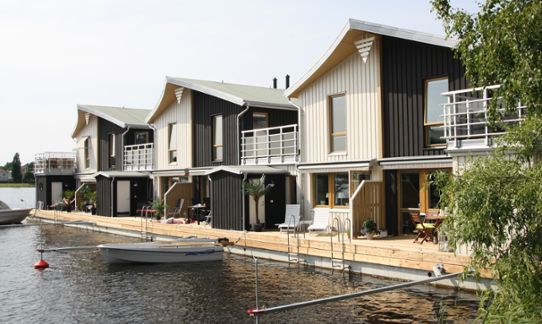Karlstad is located on the Klarälv delta and on Lake Vänern’s northern coast. This means that the city is at risk of flooding at high water levels in Lake Vänern and/or high water flows in the Klarälven river. The normal water level in Lake Vänern is approx. 44.65 metres above sea level, but in 2000, when Lake Vänern’s water levels rose and several waterfront residential areas in Karlstad were flooded, the highest level was measured at 46.0 metres. Meanwhile, a strong interest in building and living in locations close to the water, which makes these areas an important element in attracting people to the city.

During the flood in 2000, the idea of building floating homes emerged. The demand for housing near the water would be answered, while the homes would also be adapted to climate change and potential flooding.
The dwellings
A total of twelve homes divided onto two pontoons made of concrete are now secured to land by means of pressure racks, chains and Cardan joints. The fact that there is no anchorage in the seabed, makes it possible to facilitate easy removal if the dwellings need to be moved. The solution with Cardan joints (universal joints) allows the dwellings to move up, down, and sideways. This is important in order to avoid wear and tear with the tides and changing surface levels, and in the event of rough seas movement. The dwellings can manage with water level differences of up to 2.5 metres.
The greatest challenge was finding the right location for the construction project. There were a multitude of factors to consider: proper water depth, appropriately close to the land, and proximity to some of the other properties in the company’s portfolio (in order to connect to existing networks for technical supply, i.e., pipes for water supply and sanitation, district heating, and broadband Internet, etc.). The construction was also a challenge in and of itself, as there is a substantial difference between building on land and building on water.
The cost
The total costs for the dwellings was approximately SEK 30 million, or calculated per square metre, a price of approx. SEK 31,700 m³; the dwellings are 79 m³ each. The rent charged for the ranges between SEK 11,800 to 13,000 per month. Karlstad Bostads AB rents the actual water “plot” itself from Karlstad Municipality.
More examples of climate adaptation
This is one of many examples of climate adaptation. There are more in the collection of ideas being built up by the Swedish National Knowledge Centre for Climate Change Adaptation at the Swedish Meteorological and Hydrological Institute (SMHI). The collection of examples has the aim of sharing experiences and providing ideas to everyone who works with climate adaptation. Examples describe concrete measures and challenges in several subject areas. They show how different actors have worked to adapt their activities to the climate changes that are already being noticed today and those that we cannot prevent in the future.